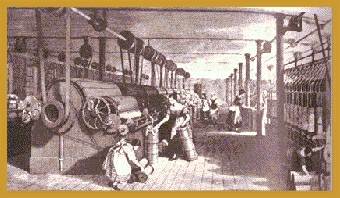|
PinkMonkey Online Study Guide-World History
8.4 Course of the Industrial Revolution
Textile Industry
The Industrial Revolution first started in the textile industry in England, in the techniques of ’spinning’ as well as of ’weaving’.
-
Hargreaves’ Spinning Jenny, 1764: Spinning
was an extremely slow process, with the spinner spinning only
one thread at a time, with the help of the spinning wheel. In
1764, James Hargreaves invented a machine called the ’Spinning
Jenny.’ It enabled a spinner to spin as many as eight to ten
threads at a time, on his new machine. This increased the production
of yarn.

Exhibit 8.2
A Textile Factory in England
-
Arkwright’s Water-Frame, 1769: In 1769,
Richard Arkwright invented a machine run by waterpower instead
of manpower. Hence it came to be called the ’Water-Frame’. This
second machine could produce stronger and finer yarn than the
Spinning Jenny. It increased the production of threads to a
very great degree, as it worked on water force.
-
Crompton’s Spinning Mule, 1778: Samuel
Crompton removed the defects of the Spinning Jenny and Water
Frame, with his machine known as ’Spinning Mule’. A spinner
could now spin threads of stronger and better quality on this
machine.
|
Index
8.0 -
Introduction
8.1 Meaning
8.2 Features of Industrial Revolution
8.3 Origin of Industrial Revolution
8.4 Course of Industrial Revolution
8.5 Spread of Industrial Revolution
8.6 Consequences of Industrial Revolution
8.7 Dates & Events
8.8 Points to Remember
Chapter 9
|